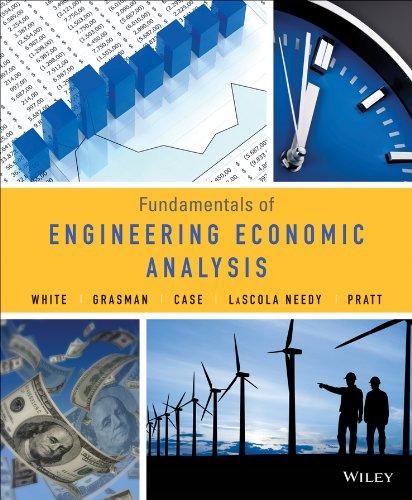1. The state of Washington must decide between three highway alternatives to replace an old winding road....
Question:
1. The state of Washington must decide between three highway alternatives to replace an old winding road. The length of the current route is 26 miles.
Planners agree that the old road must be replaced or overhauled; they cannot keep it as it is.
■ Alternative A is to overhaul and resurface the old road at a cost of
$2 million/mile. Resurfacing will also cost $2 million/mile at the end of each 10-year period. Annual maintenance will cost $10,000/mile.
■ Alternative B is to cut a new road following the terrain. It will be only 22 miles long. Its fi rst cost will be $3 million/mile with resurfacing at 10-year intervals costing $2 million/mile with annual maintenance at
$12,000/mile.
■ Alternative C also involves a new highway to be built along a 20.5-mile straight line. Its fi rst cost will be $4 million/mile with resurfacing at 10-year intervals costing $2 million/mile and with annual maintenance costing $20,000/mile. This increase over Routes A and B is due to additional roadside bank retention efforts.
Traffi c density along each of the three routes will fl uctuate widely from day to day but will average 4,000 vehicles/day throughout the 365-day year. This volume is composed of 350 light trucks, 250 heavy trucks, and 80 motorcycles, and the remaining 3,320 are automobiles. The average operation cost for each of these vehicles is $0.70, $1.10, $0.30, and $0.60 per mile, respectively.
There will be a time savings because of the different distances along each of the routes, as well as different speeds that each of the routes will sustain. Route A will allow heavy trucks to average 35 miles/hour, while the other vehicles can maintain 45 miles/hour. For each of Routes B and C, these numbers are 40 miles/hour for heavy trucks and 50 miles/hour for other vehicles. The cost of time for all commercial traffi c is valued at
$25/hour and for noncommercial vehicles, $10/hour. Twenty-fi ve percent of the automobiles and all of the trucks are considered commercial.
Finally, there is a signifi cant safety factor to be included. An excessive number of accidents per year have occurred along the old winding road.
Route A will reduce the number of vehicles involved in accidents to 105, and Routes B and C are expected to involve only 75 and 50 vehicles in accidents, respectively. The average cost per vehicle in an accident is estimated to be $18,000, considering actual property damages, lost time and wages, medical expenses, and other relevant costs.
The Washington planners want to compare the three alternative routes using benefi t-cost criteria, specifi cally the popular benefi t-cost ratio.
Step by Step Answer:

Fundamentals Of Engineering Economic Analysis
ISBN: 9781118414705
1st Edition
Authors: John A. White, Kellie S. Grasman, Kenneth E. Case, Kim LaScola Needy, David B. Pratt






